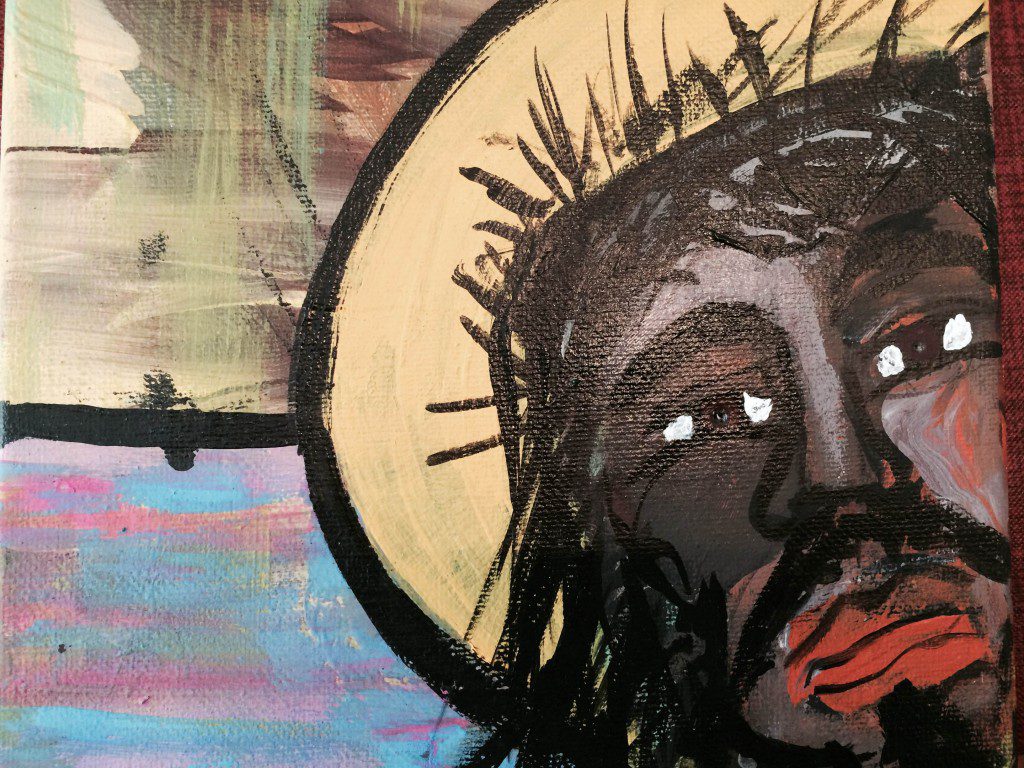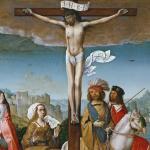Painting by Bec Cranford-Smith
What does it mean that Jesus died for humanity’s sins? It’s a question that I could answer with perfect clarity when I was a nine year-old Southern Baptist. Without batting an eye, I would have told you that Jesus had to die on the cross for our sins because otherwise God would have no choice but to torture us in hell forever. But three decades of reading the Bible since then have ruined all the simple answers I was given as a child.
For most of my life, I’ve been in search of a better way of telling the story of Jesus’ cross. And I’ve discovered that the simple phrase “Jesus died for our sins” actually has a much richer meaning than I had been given. So I wanted to share seven different aspects of the work that Jesus’ cross does to liberate humanity from sin.
1. Jesus’ cross exposes the ugliness of sin
Sin is ugly. But we usually don’t see its ugliness. We see the glamour and decadence. We see the power. We don’t see the way that our addictions, anxieties, and idols form a worldwide system of toxicity that crucifies people, from suburban heroin addicts to self-mutilating rape survivors to starving children in shantytowns. Sin often happens in private, but its effects are not private at all. They just often take place outside of our field of vision. Jesus’ cross forces us to look at the ugliness we’d just as soon ignore. The cross is not merely something that happened two thousand years ago; it is the representation of what humanity has never stopped doing to God because of how we treat each other. All of us crucify Jesus every time we sin because our collective greed, envy, and lust crucify the most vulnerable people in our societies.
2. Jesus’ cross shows solidarity with the victims of sin
Whenever marginalized people have taken hold of the Christian story, they see something very obvious that few official church theologians noticed over the centuries: Jesus’ cross shows solidarity with people who are getting crucified. It is the ultimate expression of the phrase Gabriel gave to Mary: Emmanuel – God with us. To people who have never been crucified, there are only defendants in the heavenly courtroom of sin. But sin is not a victimless crime. The heavenly courtroom is filled with plaintiffs who cry out, “How long, O Lord?” Jesus’ cross is for plaintiffs every bit as much as it’s for defendants. It says to victims of horrific sin: “They did it to me too.” Thomas Aquinas may not have covered this aspect of the cross, but the theologians of the slave plantations sure did.
3. Jesus’ cross purifies the curse of sin
Sacrifice is one of the great spiritual mysteries of human history. Civilizations throughout history all over the world have used ritual violence as a means of communal purification. The anthropologist Rene Girard studied this extensively. As communities experience layer upon layer of unresolved conflict, it bubbles into a dangerous sublimated rage that needs an object in order to be diffused. The problem is that sin can never be adjudicated perfectly. It’s a tangled up mess of mitigating circumstances and shared blame. The irresolvability of sin fills communities with what we might call “bad blood,” a vague sense of curse that has been detached from its original source. The purpose of sacrificial bloodshed is to lift the curse in the air and release the bad blood. That’s what Jesus’ blood does to the bad blood of humanity. In ancient animal sacrifices, the conclusion of the ritual was to feast together upon the animal that had been sacrificed. Likewise, through the Christian Eucharist, Jesus’ body and blood become the means by which our churches are purified of bad blood and brought into deeper harmony as the body of Christ.
4. Jesus’ cross pays the debt of sin
God is not a banker. He does not “need” to be paid in divine blood or eternal torture for our sin. However, one way that sin imprisons us is by putting us in a state of indebtedness. Imagine if you lived next door to a guy who had tons of fruit trees in his yard and every day you stole some of his fruit without asking. Then the guy invites you to a party at his house and you can tell by the look in his eyes that he’s seen everything you’ve done. Would you enjoy the party or would you find the first excuse to leave and go home? If you stayed, would the party be heaven or hell while you waited to see if he was going to confront you publicly about your sins against him? We know that God knows everything about us and that God is both perfect love and perfect truth. It would not be loving for God to pretend not to notice our sin, because dishonesty deforms us and fills us with anxiety. So God proves his love for us by paying the debt of our sin on Jesus’ cross (Romans 5:8). He makes it clear upfront that everything has been taken care of so that we can live in complete openness and freedom.
5. Jesus’ cross invites us to a life of resisting sin
Jesus’ cross does not make sense apart from his call for us to take up our crosses and follow him. When he gave this command, it didn’t have the domesticated, watered-down meaning that it does in suburban evangelical churches today. Jesus says, “Whoever wants to save their life will lose it, but whoever loses their life for me and for the gospel will save it” (Mark 8:35). For the first three hundred years of the church, Christians took Jesus’ call quite literally. And the more that they were martyred by the Roman Empire for refusing to be complicit with the sin of Roman society, the more the church spread. Christians are supposed to be called out of the world into the kingdom of God. We are called to bear our crosses in the street to resist the sinful systems of our world that oppress people. In every generation, the powerful have tried to co-opt the church by making the Christian life into compliant, orderly middle-class existence. If we are actually following Jesus, the powerful will want to crucify us, but through losing our lives and our worldly status, we will gain a life that is infinitely more meaningful.
6. Jesus’ cross sabotages the power of sin
The Roman cross was one of the most powerful tools of state terror that has ever been invented. Its purpose was to show Rome’s subjects what would happen to them if they rebelled. The sinful systems of our world retain their power because of the consequences we think we will suffer if we rebel against them. But Jesus co-opts this symbol of state terror and turns it into a symbol of the divine power of love and forgiveness. The greatest threat that the Roman Empire ever faced was an army of people who sought crucifixion as the ultimate witness of their faith. Their terror was completely defanged by the God who made it into his expression of love.
7. Jesus’ cross models the way to stand against sin
There are many ways the cross can be abused as a model for Christian life. So many abused Christian wives have been told to “bear their crosses” in secret in order to preserve their marriage. But that’s not what the cross looks like because the cross is not secret, privatized suffering. The cross is public nonviolent confrontation. The cross is standing calmly in the street while a riot cop charges you and shoots tear gas at you. The cross means refusing to be intimidated by physical violence. It means not backing down and refusing to be baited into losing control. It means being confrontational without escalating conflict. This is what destroys sin because sin perpetuates itself through cycles of reaction.
Check out my book How Jesus Saves the World From Us!
If you want to support campus ministry built on this teaching, please become a patron of our ministry NOLA Wesley or a one-time donor.

















